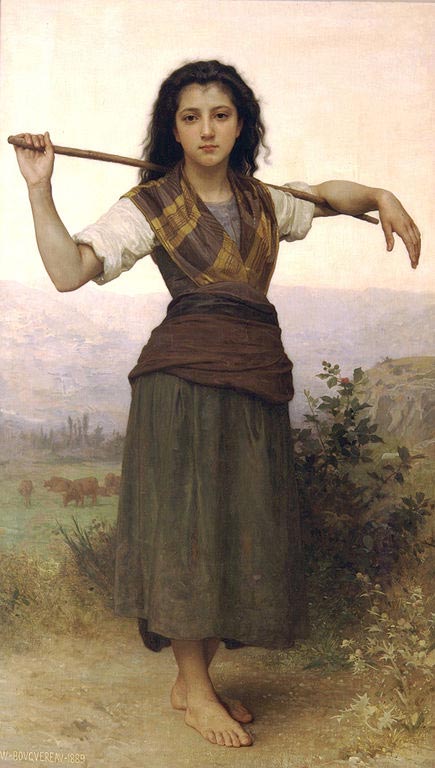| William-Adolphe Bouguereau | |
|---|---|
 |
|
| Born | Nov. 30, 1825 La Rochelle, France |
| Died | Aug. 19, 1905 (at age 79) La Rochelle, France |
| Nationality | French |
| Movement | Realism |
| Field | Painting |
| Works | View Complete Works The Birth of Venus The Bohemian |
In 2005 the J Paul Getty art museum in California decided, merely out of curiosity, to put on display three works of the long-dead 19th century French painter William-Adolphe Bouguereau.
Nobody expected the reaction: The paintings instantly became a sensation. Bouguereau’s works became the most popular paintings in a museum which also contains some of the most brilliant art from all over the world and from all the ages.
Yet, people flocked in not by the thousands, but by the tens of thousands. The Los Angeles Times reported that the halls of the Getty Museum “were clogged with people” waiting in line to see the creations of William-Adolphe Bouguereau.
The Academic Style
Bouguereau died in 1905 after a long and successful career of painting in what is known as the “Academic Style.” This is a style of painting as defined by various European institutions of art. In brief, Academic works represent and preserves a classical, representational mode of painting from Neoclassicism to Neoromanticism. Academic style is also sometimes called or compared to Historicism.
Think of the paintings of Leonardo da Vinci or the works of Michelangelo on the ceiling of the Sistine Chapel and you will get an idea of the kind of art Bouguereau devoted his life to creating.
Early Life
 Bouguereau was born in La Rochelle, France, in 1825. His family was in the wine and olive business. Like many great artists, Bouguereau displayed noticeable talent from an early age. This helped him get a place in the prestigious École des Beaux-Arts in Bordeaux, where he excelled as an art student.
Bouguereau was born in La Rochelle, France, in 1825. His family was in the wine and olive business. Like many great artists, Bouguereau displayed noticeable talent from an early age. This helped him get a place in the prestigious École des Beaux-Arts in Bordeaux, where he excelled as an art student.
Bouguereau’s talent helped him earn commissions painting portraits of the parishioners of a Catholic Church where his uncle was a priest. This in turn landed him a spot as a student of another great French artist, François-Edouard Picot. That combined with an intensive study of human anatomy (which he gained by observing actual dissections of human bodies at a medical school) crystalized his ability to create a consistent and impressive body of work over the next six decades.
Female Subjects
Bouguereau’s favorite subject was the female form. He would often reinterpret classical works, such as Botticelli’s “The Birth of Venus.” Many of his females were nudes, many were lofty depictions of both pagan goddesses and Christian figures – but he also painted wonderful images of humble women and girls contemporary to his time.
One marvelous example of the latter is Tête d’Etude l’Oiseau, completed in 1867. This is a painting of an adorable girl of about eight years of age adorned in a white blouse of flowing sleeves over a deep blue skirt. Her head is tilted upward, her face is beaming, and a delicate bird is perched on her gentle, upheld hand.
Another vivid example of Bouguereau’s ability to wonderfully capture the essence of a common person is The Shepherdess, completed in 1889. It depicts an earthy dark-haired girl of about 16 in the simple garb of a peasant, standing barefoot and with a shepherd’s rod slung across her shoulders.
Famous Across Europe and America
 During his active years throughout the 1800s, Bouguereau was revered as one of the finest painters in Europe. His work was much in demand. He became extremely popular with American millionaires who paid high prices to get their hands on a Bouguereau original.
During his active years throughout the 1800s, Bouguereau was revered as one of the finest painters in Europe. His work was much in demand. He became extremely popular with American millionaires who paid high prices to get their hands on a Bouguereau original.
Despite the nearly universal appeal of Bouguereau’s work, he was not without his critics, and those critics were ferocious. Those who were eager for the “old classical styles” to be swept away by more modern styles, such as Impressionism, spewed every manner of insult upon his works, and expressed deep loathing for an artist whom they considered stuck in the past.
Fall from Grace and Rebirth
The eventual dominance of the avant-garde crowd finally managed to sweep Bouguereau into the dust bin of history, but as we have seen, William-Adolphe Bouguereau had the last laugh. To the surprise of many, modern-day showings of his art continue to produce remarkable reactions among art lovers.
Today, Bouguereau’s works are much in demand for shows by major art institutions around the world, including the New York Cultural Center, The Wadsworth Atheneum of Hartford, Connecticut, the Montreal Museum of Fine Arts and the Musée du Petit-Palais, in Paris.
During his long career, Bouguereau created 826 works. He also stated that his life as a painter brought him “intense joy.” He said that, even after decades in front of the easel, he could scarcely wait for the night to end so that he could get up in the morning and go to his studio and paint.